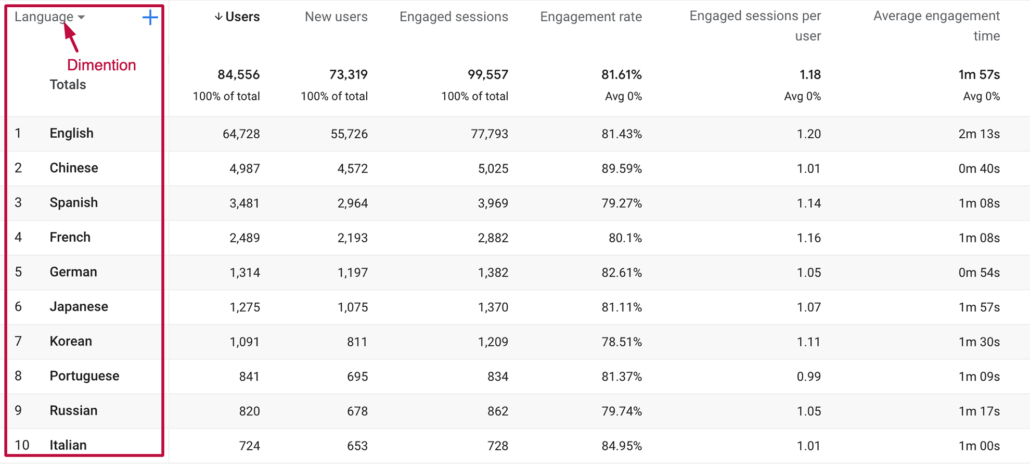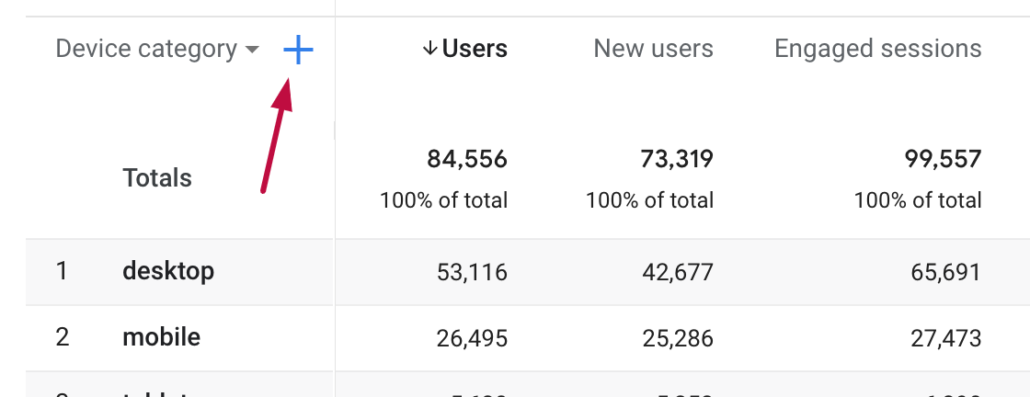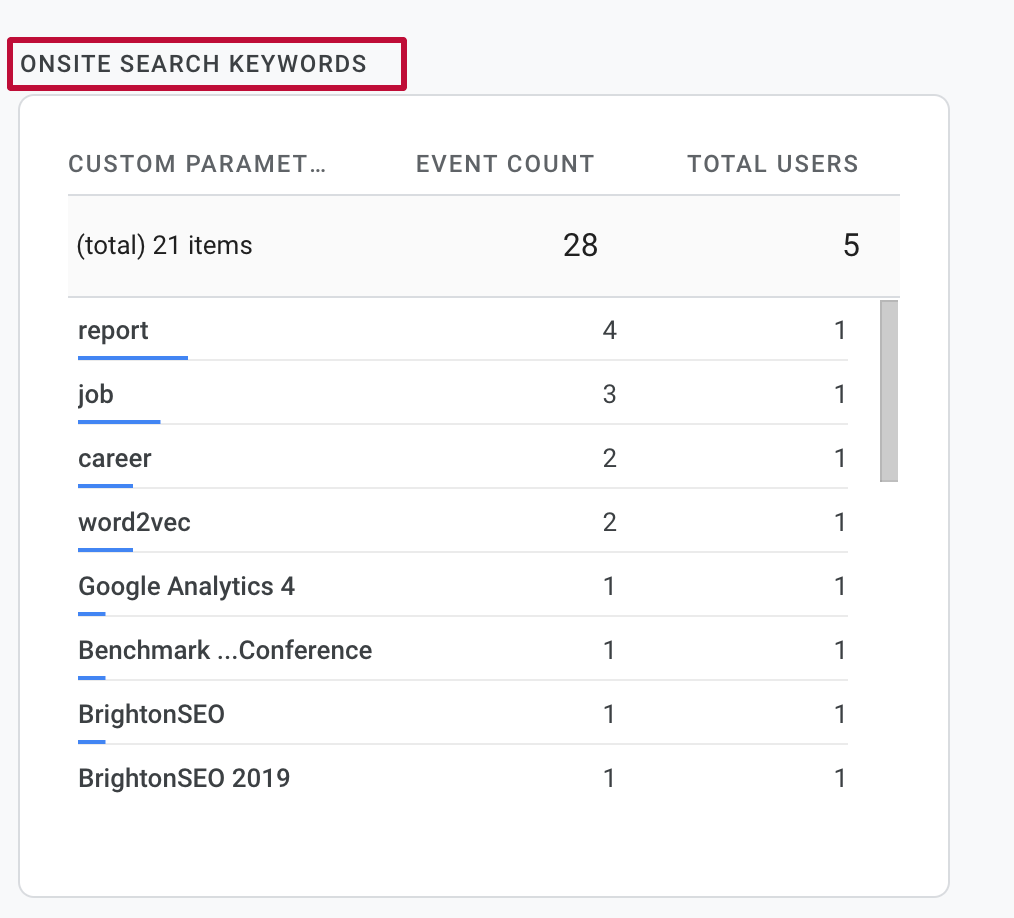What is Google Analytics?
One of the most popular ways to analyze your website’s performance is through Google Analytics. Google Analytics is a free tool that provides detailed statistics and reports about your website site’s traffic.
You can track things like site visitors, page views, and average time on site. Google Analytics also provides information about which pages were most visited and where your traffic came from (e.g., organic search, social media).
You can set up goals to track conversions and define conversion types. For example, a conversion could be a purchase, a sign-up for a mailing list or an event. You can set up custom alerts to trigger notifications when a goal is reached or a conversion type is created.
Every report in Google Analytics is made up of dimensions and metrics so in this article I’ll walk you through how to use these insights to boost your online strategy.
What’s a dimension in Google Analytics 4?
Let’s start with the basics as some readers of this article might be actually new to Google Analytics (GA).
Simply put, a dimension in Google Analytics 4 is a description, characteristic, parameter or attribute or of your data. It might be a feature of a user, website, product, event, etc. It helps us better describe and understand our data so it makes sense to look at it as a qualitative variable.
With that in mind, another way to describe a dimension in Google Analytics would be ‘ a qualitative variable (a variable that isn’t numerical) that describes data that fits into categories’.
If this does not sound clear, let me give you a couple of examples of metrics:
- Source/Medium
- Device
- Language
- Page
- Age
- Products
Notice that all dimensions comprise of words, not numbers and although some dimensions are expressed in numbers, like hours and dates they still describe the data that’s collected.
Google Analytics 4 (GA4) normally displays data in its reports in the form of a data table and you can see dimensions in the first column of your reports.

Each dimension accepts different values. As an example, the dimension ‘Operating System’ shows the operating system that the visitor used and accepts as values Windows, Macintosh, Android, iOS etc. These values help you understand and sort the traffic between the different operating systems.

Consider another example:
The ‘Device Category’ dimension gives us the type of device that the visitor has used when visiting our website and this dimension accepts mobile, desktop and tablet as its values.
It goes without saying that knowing what browsers and devices your website/app is accessed from can help you focus your testing on the devices and browsers that your customers are in fact using.

What is a Secondary Dimension in Google Analytics 4?
Every report in GA4 comes with a pre-selected primary dimension that provides high-level insights into how the dimension performs in relation to a set of metrics. To make life more interesting Google also gives us the option to segment our dimension data further by adding a ‘Secondary Dimension’. This gives us the opportunity to designate a primary dimension and then view the related data by a secondary dimension within the same table.
The whole process is as simple as clicking on the ‘+’ button next to the primary dimension.

Using Device Category as a main dimension and Country as a second dimension we can review how people from different countries access our website properties.
In the example below, we can see that people from the United States visit the Google Merchandise Store primarily using desktop and although the difference between the total number of active users using desktop and mobile is not that big the ‘desktop revenue’ is significantly higher.

This is a good example of how a secondary dimension can give you the context you need to make informed decisions for your business.
How to apply more than two dimensions in Google Analytics 4
By default Google Analytics 4 only allows applying 2 dimensions to a report but if you want to apply more than two dimensions you can always build a custom report in the ‘Explore’ section of GA4 as I’ve shown you in the ‘Landing page report in Google Analytics 4‘.
What is a custom dimension in Google Analytics 4?
Similar to other analytics tools Google Analytics 4 was not built specifically for your business so it won’t give you everything you need ‘out of the box.’ Although Google Analytics 4 gives us a lot of dimensions, as your business is unique you might find yourself wanting to work with a dimension that GA4 might not provide.
For example, I might want to track my website tags, categories or blog authors. WordPress category and tag pages can be an important source of organic traffic. This is why I might want to track them properly, so I can better understand their impact. This is where custom dimensions in Google Analytics 4 can be utilised.
How to create a custom dimension in Google Analytics 4?
In this article, I will not deep dive into custom dimensions in Google Analytics 4 but it’s still worth mentioning that the session scope is no longer available in GA4 and your custom dimension scope will no longer be set to the hit level as it was in Universal Analytics (source).
In short, this means that every custom dimension in Google Analytics 4 is always describing the event that is sending it.
Creating a custom dimension in GA4 is as simple as:
- Go to the ‘Custom Definitions’ report under ‘Configure’ and click on ‘Create Custom Dimension.’
- Name your dimension. (In my case, I call it ‘OnSite Search Keywords’ so later on I can show you how to find your custom dimension).
- Define the scope of your custom dimension – ‘Event’ or ‘User’.
- In the ‘Description’ box write a description of your custom dimension that makes it understandable in the future what you are trying to track.
- Finally, choose the ‘Event Parameter’ and then click ‘Save’. (As I want to know what was searched on my website I have to select ‘search_term’)

Note: In Google Analytics 4 you can set up 50 custom dimensions and 50 custom metrics per property (source) and of course if you buy Google 360 you will be given a higher number. Also, Google is constantly changing the position of the ‘Configure’ tab. As of today, you can find it in the top left corner of your browser.

Where to find your custom dimension data?
To find your custom dimension data go to ‘Events’ under ‘Engagement’ and click on the event your custom dimension is based on. In our example, this is ‘view_search_results’. Scrolling to the bottom of my dashboard I can now see the words my visitors are searching for when they arrive on https://omisido.com/.

Note: It takes about 24 hours until you can see your custom dimension data and during this time you may see a value of “not set” (source).
What are metrics in Google Analytics 4?
Now that we know what dimensions are, I believe it will be much easier to explain metrics. A metric in Google Analytics 4 is the quantitive measurement of data (time, %, number values etc.) that shows how our website is performing in a relation to a specific dimension.
For example, going back to the ‘Device Category’ dimension example above the number of ‘Users’ who came from ‘desktop’ is a metric to the Device Category dimension. Or the number of ‘Conversions’ and ‘Total Revenue’ are the metrics to the location dimension ‘United States.’

Note: Metrics and dimensions are helpful for analysing your data, but they’re nonsensical without each other.
What is a custom metric in Google Analytics 4?
Similar to the dimension case, although Google gives us a lot of metrics in their analytical tool they simply can not cover every single scenario. So if we want to measure the characteristics of a dimension (predefined or custom) that do not come as default we have to create and use custom metrics.
If I have to be entirely honest with you 2-3 years ago I couldn’t be bothered to learn how to set up my custom metrics but nowadays I’m implementing or analysing reports in search of insights based on custom metrics almost every single day. We all work with different business models so custom metrics are like Google Analytics on steroids.
Note: It’s against the Google Analytics terms of services to send personally identifiable information to your GA4 as a custom metric (source). Example: address, phone number, national insurance number, etc.
How to create custom metrics in Google Analytics 4?
Similar to custom dimensions setting a custom metric in GA4 is super easy and intuitive. Custom metrics in GA4 always have an event scope (in Universal analytics the scope was either Hit or Product) meaning that the value of a custom metric is sent for each event. With that in mind, you can look at custom metrics in Google Analytics 4 as custom parameters. Each parameter can be an automatically collected parameter or a custom parameter.
Creating a custom metric in Google Analytics 4 using a default parameter
- Go to the “Custom Definitions report under ‘Configure’ and click on ‘Create Custom Metric.’
- Name your metric. I will call mine ‘Video watching time in minutes’. As usual, be as specific as possible as this name will appear in your Google Analytics reports.
- You only have one option for scope and this is ‘Event’
- In the ‘Description’ box describe your custom metric so in the future you or your colleagues can easily understand what’s been measured.
- In the ‘Event parameter’ box enter the event parameter for your custom metric (in my case I simply copied video_progress from Google’s GA4 Enhanced measurement page).
- Finally, select the ‘Unit measurement (compulsory) and hit ‘Save’. Note that you can always change the unit of measurement at a later time.

Note: There is a difference between custom metrics and calculated metrics in GA4. ‘Custom metrics’ serve to gather data that GA4 doesn’t automatically collect, whereas ‘Calculated metrics‘ are employed to collect/compute new data based on the existing data within GA4.
Where to find your custom metric data?
Similar to custom dimension it takes about 24 hours until you can see your custom metric data. You can find your data under the Events report. In my case, as I am tracking the average amount of playtime watched per video I have to click on the video_progress event which takes me to the video_progress event page and if I scroll down I can see the custom card named ‘Video Progress’.
The data from this custom metric will now appear in every report where GA4 is passing the video_duration parameter together with the event.
Final thoughts
This is a quick overview of dimensions and metrics in Google Analytics 4 so don’t stop here as there’s a lot more to find out about your website visitors, and with the new A.I. powered predictions and insights, customer-centric measurements and improved granular control.
Google Analytics 4 is a free powerful tool for understanding the performance of your website. You can use this data to gain insight into what content resonated most with your visitors, how far they scrolled down your page, which pop-ups are most effective, where people are abandoning the site, and more!
GA4 allows you to dig deeper like never before and get to know your visitors better, helping you improve your marketing decisions and get better ROI.



Leave a Reply